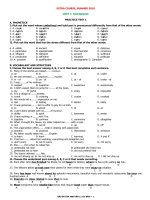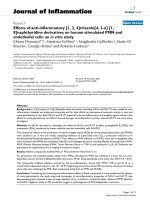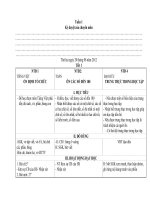Bsi bs au 050 1 2 4 1994 (1999) iso 10454 1993
Bạn đang xem bản rút gọn của tài liệu. Xem và tải ngay bản đầy đủ của tài liệu tại đây (290.54 KB, 12 trang )
BRITISH STANDARD
Tyres and wheels —
Part 1: Tyres —
Section 2: Commercial vehicle tyres —
Subsection 2.4 Method of test for
verifying tyre capabilities
BS AU
50-1.2.4:1994
ISO 10454:
1993
BS AU 50-1.2.4:1994
Committees responsible for this
British Standard
The preparation of this British Standard was entrusted by the Automobile
Standards Policy Committee (AUE/-) to Technical Committee AUE/4, upon
which the following bodies were represented:
Agricultural Engineers’ Association
Automobile Association
British Industrial Truck Association
British Pressure Gauge Manufacturers’ Association
British Rubber Manufacturers’ Association
Bus and Coach Council
Department of Transport
Freight Transport Association
Institute of Road Transport Engineers (Inc)
Motor Cycle Industry’s Association of Great Britain Ltd.
Motor Industry Research Association
National Tyre Distributors’ Association
Retread Manufacturers’ Association
Road Haulage Association Ltd.
Society of Motor Manufacturers and Traders Ltd.
This British Standard, having
been prepared under the
direction of the Automobile
Standards Policy Committee,
was published under the
authority of the Standards
Board and comes
into effect on
15 January 1994
Amendments issued since publication
© BSI 12-1999
Amd. No.
The following BSI references
relate to the work on this
standard:
Committee reference AUE/4
Draft for comment 90/81368 DC
ISBN 0 580 22717 0
Date
Comments
BS AU 50-1.2.4:1994
Contents
Page
Committees responsible
Inside front cover
National foreword
ii
1
Scope
1
2
Normative reference
1
3
Definitions
1
4
Test equipment
1
5
Testing
2
6
Requirements
3
Annex A (informative) Test conditions for tyres with non-standard marking 5
Annex B (informative) Bibliography
6
Table 1 — Plunger diameter
2
Table 2 — Endurance test parameters
3
Table 3 — Minimum breaking energy
4
Table A.1 — Plunger diameter
5
Table A.2 — Endurance test
5
Table A.3 — Minimum breaking energy
6
List of references
Inside back cover
© BSI 12-1999
i
BS AU 50-1.2.4:1994
National foreword
This Subsection of this Part of BS AU 50 has been prepared under the direction
of the Automobile Standards Policy Committee and is identical with
ISO 10454:1993 Truck and bus tyres — Verifying tyre capabilities — Laboratory
test methods, published by the International Organization for Standardization
(ISO). Other Parts of this standard are as follows:
— Part 2: Wheels and rims;
— Part 3: Valves;
— Part 4: Rim profiles and dimensions.
Cross-references. The Technical Committee has reviewed the provisions of
ISO 4223-1:1989 to which normative reference is made in the text and has
decided that they are acceptable for use in conjunction with this standard.
A British Standard does not purport to include all the necessary provisions of a
contract. Users of British Standards are responsible for their correct application.
Compliance with a British Standard does not of itself confer immunity
from legal obligations.
Summary of pages
This document comprises a front cover, an inside front cover, pages i and ii,
pages 1 to 6, an inside back cover and a back cover.
This standard has been updated (see copyright date) and may have had
amendments incorporated. This will be indicated in the amendment table on the
inside front cover.
ii
© BSI 12-1999
BS AU 50-1.2.4:1994
1 Scope
3.5
cracking
This International Standard specifies test methods
for verifying the capabilities of truck and bus tyres.
Of the test methods presented, only some may be
required depending on the type of tyre to be tested.
The tests are carried out in a laboratory under
controlled conditions.
It includes a strength test for assessing the
capability of the tyre structure, with respect to
braking energy, in the tread area.
A second test, the endurance test, assesses the
resistance of the tyre with respect to service at full
load and moderate speed over long distances.
The test methods presented in this International
Standard are not intended for gradation of tyre
performance or quality levels.
This International Standard applies to all truck and
bus tyres.
2 Normative reference
The following standard contains provisions which,
through reference in this text, constitute provisions
of this International Standard. At the time of
publication, the edition indicated was valid. All
standards are subject to revision, and parties to
agreements based on this International Standard
are encouraged to investigate the possibility of
applying the most recent edition of the standard
indicated below. Members of IEC and ISO maintain
registers of currently valid International Standards.
ISO 4223-1:1989, Definitions of some terms used in
the tyre industry — Part 1: Pneumatic tyres.
3 Definitions
For the purposes of this International Standard, the
definitions given in ISO 4223-1 and the following
definitions apply.
3.1
bead separation
breakdown of bond between components in the bead
area
3.2
belt separation
parting of rubber compound between belt layers or
between belts and plies
3.3
chunking
breaking away of pieces of the thread
3.4
cord separation
cord parting from adjacent rubber compounds
© BSI 12-1999
any parting within the tread, sidewall or innerliner
of the tyre extending to cord material
3.6
innerliner separation
parting of innerliner from cord material in the
carcass
3.7
maximum load rating
maximum load that the tyre is rated to carry in
single formation at the reference speed
3.8
open splice
any parting at any junction of tread, sidewall or
innerliner that extends to cord material
3.9
ply separation
parting of rubber compound between adjacent plies
3.10
sidewall separation
parting of the rubber compound from the cord
material in the sidewall
3.11
special tread tyre (ET)
tyre whose tread pattern is primarily designed to
provide satisfactory performance under special
service conditions (e.g. mixed use, on-and off-road,
city bus, etc.)
3.12
test rim
any rim on which the tyre may be fitted that
conforms to the dimensions of the recommended
rims for the particular tyre designation and type
3.13
test drum speed
peripheral speed of the steel test drum
3.14
tread separation
pulling away of the tread from the tyre carcass
4 Test equipment
The test equipment consists of items in 4.1 to 4.3 .
4.1 Test drum, cylindrical driven flywheel (drum)
having a diameter of 1,7 m ± 1 % or 2 m ± 1 %.
The surface of the drum shall be smooth steel. The
width of the test surface shall be equal to or exceed
the overall width of the test tyre.
1
BS AU 50-1.2.4:1994
For the test drum, the loading device may be a
dead-weight cantilevered system with a hydraulic
or pneumatic system. The accuracy shall be
within ± 1,5 % of the full scale.
For the test drum, the speed capability of the
equipment shall be adequate for the requirements of
the test methods. The accuracy of the test drum
speed shall be within +20 km/h at the full scale.
4.2 Plunger, cylindrical steel plunger of sufficient
length with a hemispherical end and a diameter as
shown in Table 1, with reference to the tyre load
index.
For the plunger equipment, the loading device shall
permit gradual application of the force. Indicators of
displacement and of force shall be provided with an
accuracy within ± 1 % of full scale.
For the plunger equipment, the speed of the
displacement shall be controlled with an accuracy
within ± 3 % of the full scale.
Table 1 — Plunger diameter
Dimensions in millimetres
Load index in single
formation
u 121
122 – 134
W 135
Plunger diameter
± 0,5
19
32
38
4.3 Inflation pressure gauges, with a maximum
scale value of at least 1 000 kPa with an accuracy
within ± 20 kPa.
5 Testing
5.1.2.4 if the tyre fails to break before the plunger is
stopped on reaching the rim and the required
minimum breaking energy is not achieved, then the
tyre is deemed to have passed the test at that point.
5.1.2.5 Compute the breaking energy, W, in joules
for each test point, except those considered
by 5.1.2.4 , by means of the following formula:
W = F× P
where
2 000
F is the force, in newtons;
P is the penetration, in millimetres.
5.1.2.6 Determine the breaking energy value for the
tyre by computing the average of the values
obtained.
5.1.2.7 When an appropriate device which
automatically evaluates the value of the energy W is
available, the penetration can be stopped shortly
after having achieved the prescribed value.
5.1.2.8 In the case of tubeless tyres, means may be
provided to ensure the retention of the inflation
pressure for the duration of the test.
5.2 Endurance test
5.2.1 Preparation of tyre
5.2.1.1 Mount the tyre on a test rim and inflate to
the pressure corresponding to the maximum load
rating.
5.2.1.2 Maintain the tyre and rim assembly at
ambient temperature, which shall be at least 20 °C,
for at least 3 h.
5.2.2 Test procedure
5.2.2.1 Readjust the tyre pressure to the value
5.1 Strength test
specified
in 5.2.1.1 immediately before testing.
5.1.1 Preparation of tyre
5.2.2.2 Mount the tyre and rim assembly on a test
5.1.1.1 Mount the tyre on a test rim and inflate it to axle
so that the tyre may be pressed radially against
the pressure specified for the maximum load rating
in single formation, or maximum dual load, where
they differ.
5.1.1.2 Maintain the assembly at test room
temperature for at least 3 h.
5.1.2 Test procedure
5.1.2.1 Readjust the tyre pressure to that specified
in 5.1.1.1 and mount the assembly on a fixture.
5.1.2.2 Position the plunger as near to the centreline
as possible, avoiding penetration into the tread
grooves, and force the plunger perpendicularly into
the tread at a rate of 50 mm/min ± 2,5 mm/min.
5.1.2.3 Record the force and penetration at the
moment of breaking (see also 5.1.2.7 ) at each of five
test points approximately equally spaced around
the circumference of the tyre. Check the pressure
before moving to the next test point.
2
the outer face of the test drum.
5.2.2.3 During the test the ambient temperature
shall be maintained at between 20 °C and 30 °C, or
at a higher temperature if the tyre manufacturer
agrees.
5.2.2.4 Conduct each successive phase of the test,
without interruptions, at the test speed with loads
and test periods as shown in:
a) Table 2 a) for tyres with load index (single) up
to 121 inclusive and speed symbol up to P;
b) 5.2.3 for tyres with load index (single) up
to 121 inclusive and speed symbols Q and above;
c) Table 2 b) for tyres with load index (single) 122
and above.
© BSI 12-1999
BS AU 50-1.2.4:1994
Table 2 — Endurance test parameters
Load as percentage of maximum load rating
Test drum speed a
r/min
Speed symbol
Radial tyres
Diagonal tyres
a) Tyres with load index (single) u 121
100
125
150
175
175
200
—
—
b) Tyres with load index (single) W 122
100
100
F
100
125
G
125
150
J
150
175
K
—
200
L
—
225
M
F
G
J
K
L
M
N
P
100
125
150
175
200
250
275
300
Duration
16 h
(period 2)
7h
(period 1)
24 h
(period 3)
66
84
101
70
88
106
75 b
97 b
114
66
84
101
a Special tread tyres shall be tested at a speed equal to 85 % of the speed prescribed for equivalent normal
b The load application times for periods 1 and 2 are 4 h and 6 h respectively.
tyres.
5.2.2.5 Throughout the test, the inflation pressure
6 Requirements
5.2.3 Specific conditions for tyres with speed
Two tyres with identical characteristics, e.g. size
designation and service description or maximum
load rating and speed capability, shall comprise a
test sample:
a) one tyre shall be used for the measurement of
strength;
b) a second tyre for the endurance test.
The pressures, loads, speeds and durations shall be
as specified for each test method.
Each test sample shall conform to the requirements
specified in 6.2 and 6.3 .
shall not be corrected and the test load shall be
maintained constant.
symbol Q and above
5.2.3.1 The load applied shall be:
a) 90 % of the maximum load rating on 1,7 m
drum diameter;
b) 92 % of the maximum load rating on 2 m drum
diameter.
5.2.3.2 The initial test speed shall be equal to the
tyre’s speed category minus 20 km/h.
5.2.3.3 Operate the equipment to bring the test
drum speed up to the initial test speed over a period
of 10 min.
5.2.3.4 Operate the equipment with the test drum
speed at the initial test speed for 10 min then, at the
initial test speed plus 10 km/h for at least 10 min.
Finally, operate the equipment for 30 min at the
tyre’s speed category.
5.2.3.5 The total duration of the test is 1 h.
© BSI 12-1999
6.1 Test sample
6.2 Strength test
Each test sample shall meet at least the
requirements for minimum breaking energy
specified in Table 3, when tested in accordance
with 5.1 .
3
BS AU 50-1.2.4:1994
6.3 Endurance test
6.3.1 When the tyre has been subjected to the
laboratory endurance test specified in 5.2 , using a
test rim and a valve which undergo no permanent
deformation and allow no loss of air, there shall be
no visual evidence of tread, sidewall, ply, cord,
innerliner, belt or bead separation, chunking, open
splices, cracking or broken cords.
6.3.2 The tyre pressure measured immediately after
the test shall not be less than the initial pressure
specified in 5.2.1.1 .
Table 3 — Minimum breaking energy
Breaking energy
Inflation pressure corresponding to maximum
load rating
min.
kPa
a) Tyres with load index (single) u 121
J
Nominal rim diameter
code < 13
up to 250
251 to 350
351 to 450
451 to 550
551 to 650
over 650
136
203
271
—
—
—
up to 550
551 to 650
651 to 750
751 to 850
851 to 950
972
1 412
1 695
2 090
2 203
b) Tyres with load index (single) W 122
4
Nominal rim diameter
code W 13
294
362
514
576
644
712
© BSI 12-1999
BS AU 50-1.2.4:1994
Annex A (informative)
Test conditions for tyres with non-standard marking
For an interim period, it is permissible for tyres not to be marked with a load index, but with a “load range”
or equivalent ply rating “PR” marking. Table A.1, Table A.2 and Table A.3 apply in place of Table 1,
Table 2 and Table 3 respectively.
Table A.1 — Plunger diameter
Dimensions in millimetres
Plunger diameter
Tyre type
± 0,5
Tyres marked “LT”
Tyres with rim diameter code u 12
Tyres with rim diameter code u 17.5 and marked “TUBELESS”
Other than above:
— Tyres marked LOAD RANGE F (or 12PR) and below
— Tyres marked LOAD RANGE G (or 14PR) and over
19
32
38
Table A.2 — Endurance test
Marking of speed
restricted service
50 mile/h
50 mile/h
35 mile/h
(no markings)
a4
b6
Load range
all
C, D
E to L
all
A to D
E
F
G
H to N
PR
all
6; 8
10 to 20
all
2 to 8
10
12
14
16 to 24
Test drum speed
r/min
125
150
100
75
250
200
200
175
150
Percentage of maximum load rating
Duration
7h
16 h
24 h
(period 1)
(period 2)
(period 3)
66
75
66
66
75 a
70
66
66
66
84
97
84
84
97b
88
84
84
84
101
114
101
101
114
106
101
101
101
h for tyres with rim diameter code 14.5 or less.
h for tyres with rim diameter code 14.5 or less.
© BSI 12-1999
5
BS AU 50-1.2.4:1994
Table A.3 — Minimum breaking energy
Breaking energy
min.
Load range
PR
J
Rim
diameter
code u 12
Rim diameter code 13
and 14
Tube type marked “LT”
Other tyres marked “LT”
Tubeless with rim diameter
code 13 to 17.5 inclusive
Other tyres
Tube tyre Tubeless
A
2
68
—
2 26
—
—
B
4
1 36
1 92
2 94
—
—
C
6
2 03
2 71
362
768
576
D
8
2 71
384
51 4
893
734
E
10
339
—
576
1 41 2
972
F
12
407
—
644
1 785
1 41 2
G
14
71 2
2 282
1 695
H
16
768
2 599
2 090
J
18
—
2 82 5
2 2 03
L
20
—
3 051
—
M
22
—
3 22 0
—
N
24
—
3 390
—
—
—
Annex B (informative)
Bibliography
[1 ] ISO 3877- 1 : 1 978,
[2] ISO 4209- 1 : 1 988,
[3] ISO 4209- 2 : 1 987,
6
Tyres, valves and tubes — List of equivalent terms — Part 1: Tyres
Truck and bus tyres and rims (metric series) — Part 1: Tyres
Truck and bus tyres and rims (metric series) — Part 2: Rims
.
.
.
© BSI 1 2- 1 999
BS AU 50-1.2.4:1994
List of references
See national foreword.
© BSI 1 2- 1 999
BS AU
50-1.2.4:1994
ISO 10454:
1993
BSI — British Standards Institution
BSI is the independent national body responsible for preparing
British Standards. It presents the UK view on standards in Europe and at the
international level. It is incorporated by Royal Charter.
Revisions
British Standards are updated by amendment or revision. Users of
British Standards should make sure that they possess the latest amendments or
editions.
It is the constant aim of BSI to improve the quality of our products and services.
We would be grateful if anyone finding an inaccuracy or ambiguity while using
this British Standard would inform the Secretary of the technical committee
responsible, the identity of which can be found on the inside front cover.
Tel: 020 8996 9000. Fax: 020 8996 7400.
BSI offers members an individual updating service called PLUS which ensures
that subscribers automatically receive the latest editions of standards.
Buying standards
Orders for all BSI, international and foreign standards publications should be
addressed to Customer Services. Tel: 020 8996 9001. Fax: 020 8996 7001.
In response to orders for international standards, it is BSI policy to supply the
BSI implementation of those that have been published as British Standards,
unless otherwise requested.
Information on standards
BSI provides a wide range of information on national, European and
international standards through its Library and its Technical Help to Exporters
Service. Various BSI electronic information services are also available which give
details on all its products and services. Contact the Information Centre.
Tel: 020 8996 7111. Fax: 020 8996 7048.
Subscribing members of BSI are kept up to date with standards developments
and receive substantial discounts on the purchase price of standards. For details
of these and other benefits contact Membership Administration.
Tel: 020 8996 7002. Fax: 020 8996 7001.
Copyright
Copyright subsists in all BSI publications. BSI also holds the copyright, in the
UK, of the publications of the international standardization bodies. Except as
permitted under the Copyright, Designs and Patents Act 1988 no extract may be
reproduced, stored in a retrieval system or transmitted in any form or by any
means – electronic, photocopying, recording or otherwise – without prior written
permission from BSI.
This does not preclude the free use, in the course of implementing the standard,
of necessary details such as symbols, and size, type or grade designations. If these
details are to be used for any other purpose than implementation then the prior
written permission of BSI must be obtained.
BSI
389 Chiswick High Road
London
W4 4AL
If permission is granted, the terms may include royalty payments or a licensing
agreement. Details and advice can be obtained from the Copyright Manager.
Tel: 020 8996 7070.



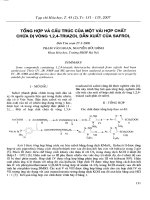
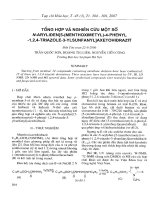
![TỔNG HỢP MỘT SỐ N-ARYL/HETARYL 2-{4-AMINO-5-[(4,6-DIMETHYL PYRYMIDIN-2-YLTHIO)METHYL]-4H-1,2,4-TRIAZOL-3-YLTHIO}ACETAMIDE](https://media.store123doc.com/images/document/14/y/vn/medium_Yr8VohbjEU.jpg)
